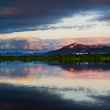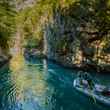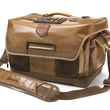The Alaskan rainforest is a primal place. In vast stretches of the Tongass, where the old growth hasn’t met the saw, it’s downright Jurassic.
Big ferns mingle with evil devil’s club and high-bush blueberries, cranberries and huckleberries to create a sweet, yet perilous paradise for everything from bald eagles to brown bears.
And fish. Lots and lots of fish.
Scott McAuliffe spends his summers chasing those fish, and showing visiting anglers some of Wrangell Island’s rainforest streams that teem with sea-run cutthroat trout, bullish Dolly Varden and, of course, all the Pacific salmon that course up these waters each summer and fall. When the season ends, and the high snow starts to fly, McAuliffe turns into an honest-to-God Alaskan fur trapper, running a trap line via snow machine into the Tongass backcountry in search of marten and a host of other furry critters.
“It’s a great way to live,” he says, as we park at a little U.S. Forest Service campground on the banks of a tannin-stained stream shaded by massive spruce and cedar trees. “I have everything I need, and if I need to get out of here, I just go visit my brother down in Yuma.”
More Like This
McAuliffe is one of only a handful of fly fishing guides on the Tongass who take clients out during the summer months to chase trout, char and salmon under the rainforest canopy. For reasons he can’t describe, many fly fishers deem the quarry found in these forests less worthy than the storied Alaskan rainbows that course through the rivers and streams of Bristol Bay or along the fabled Kenai.
“I can’t explain it, really,” McAuliffe says. “There are incredible fish in these streams, and they are truly great targets for fly fishermen. They can be challenging and they all fight really well. They deserve more respect than they get; that’s for sure.”
As we step off the old logging road and wander down a well-used bear trail along the river into the rainforest, a bald eagle—one of a dozen or so we see that day—lifts off from the top of a hundred-foot-tall spruce tree and glides down the stream corridor, scolding us for invading its fishing waters. McAuliffe smiles and points to the bird.
“You just don’t fish with eagles everywhere you go,” he says watching the giant raptor as it uses the river corridor as an avian highway. The birds perch high in the branches of the rainforests cedars, spruce and hemlock, where they keep a sharp eye on the water in search of trout and salmon. Here in Southeast Alaska, they’re more opportunists than true hunters—often, they’ll let the region’s black and brown bears do the bulk of the work, swooping in only to pick a carcass clean after the bears have done their thing.
The upper stretches of this particular stream are choked with coastal cutthroat trout, restless fish that spend their summers following Southeast Alaska’s salmon from the salt to the spawning redds, where they steal stray eggs and occasionally hit a streamer on the swing. Then, when the salmon spawn and die, the cutties vanish into the high lakes for the winter, where they chase sockeye and coho smolt through the winter until they’re fat and happy. Come spring, they migrate back into the streams, spawn themselves, and then head out to the salt to feed on smolt and other small fish until the salmon come back again. These aren’t little cutts, either—these opportunists hit hard and often, charging from the depths of deep, dark pools where they wait in ambush for hot-pink conehead ‘buggers, dart-like Polar Shrimp or gawdy, brightly colored rabbit-fur creations that jiggle in the current. On this day, McAuliffe put us on cutthroats ranging from 15 to 18 inches long, with a fish or two that might have tickled 20 inches.
Standing at the head of a deep pool that swirls around a sharp bedrock abutment, I pull fish after fish from the water, each time catching myself uttering something like, “Oh, man, that’s a nice fish.”
Truth is, they are all nice fish. Beefy and hungry, they’d likely still be hitting streamers if I’d stayed there on that little rocky platform casting to them. When the action slows down, I simply change flies. It starts right up again.

But I want to see the salt, and see if any pink salmon and Dolly Varden have showed up in the fresh yet. The salmon are running behind schedule in this little corner of Alaska. Usually this stream would be choked full of pinks and chums and a few sockeyes would be holding in the deeper water. And, in addition to the cutts, the Dollies would be here, too, waiting among the salmon and bullying the cutthroats here and there in hopes of catching a stray salmon egg that escapes from a salmon redd.
But not this day, and McAuliffe is as perplexed as I am. It’s late July. Farther north, the pinks have been running for weeks. The 2013 pink run was legendary—logic would dictate that such a big run two years earlier would result in a massive run this year (pinks spend two years in the salt before they return to their natal streams).
As we walk down the river among the spires of spruce and cedar, we flush more eagles, who, presumably, are also confused at the lack of salmon. Then McAuliffe puts us over a deep run just a few hundred yards from the stream’s estuary. In the distance, seagulls swarm over the mouth of the river, and even from here, we can see fish from jumping just yards from the fresh water. McAuliffe is noticeably relieved.
Moments later, after drifting a pink egg pattern through the run, McAuliffe is even more pleased—the first pink salmon of the day slams his fly and the fight begins.
It’s short-lived—McAuliffe is using a supple Tenkara rod for the first time, and the leaders snaps on the sharp teeth of the humpy.
“I think they’re just waiting on the water,” he says. It’s been a dryer-than-normal summer in the region and the pinks likely need a rush of fresh water to race down the area’s rivers in order to really start running in earnest. But, between the leaping pinks in the estuary and the hook-up in the deep run near the river mouth, they can’t be far from a big push.
“You’ve spent the day chasing fish that a lot of fly fishermen don’t bother chasing,” he says. “But I’ll tell you what. These fish are a blast. When people figure it out, they’re going to realize that fly fishing in the rainforest is an amazing experience.”
I take a quick look around. Whispy Spanish moss drapes from the branches of unbelievably tall trees lining the stream. It’s a rare partly sunny day, and the air is sultry, if not actually warm. Everything is green. Everything courses with life. Fly fishing here is, indeed, a special experience, one that should be enjoyed by more anglers who have yet to witness a pink salmon slam a fly, or have a 24-inch Dolly hammer a streamer. In some corners of the region, massive king salmon run into the streams starting in July, and silvers start to show up in mid- to late August. It’s a fly fishing paradise.
And, for now, for just about any fly fisher, it’s a paradise that can be enjoyed without seeing another angler for days at a time.
“I’m OK with that,” McAuliffe says. “Either people will figure it out or they won’t. Even if they do, there’s so much water here. There’s enough for everybody.”
If you go
When: The first salmon to run into the streams on Wrangell Island are usually sockeyes, which don’t normally hit flies (although they can be “flossed” with flies—they’re legal so long as they are hooked in the mouth). But, on streams with strong sockeye runs, the salmon will be accompanied by sea-run cutthroat trout and Dolly Varden, which will eagerly hit egg patterns, pegged beads and streamers. They normally run in early to mid-July. Pinks and chum salmon usually start to show up by mid-July and they’ll run in earnest well into August. Silvers usually start showing up in mid-August, and they can run through September. For die-hards like McAuliffe, there are runs of truly giant steelhead in the spring, but runs are small and spread out through the region. They can be fished, but they’re challenging.
Where to stay: Wrangell has a colorful history, first as a Tlinget (pronouced locally as Klinket) stronghold, and later as a mining town, a timber town and finally a fishing town. It was a rough-and-tumble place back in the late 1800s and early 1900s—Wyatt Earp once served a 10-day stint as the town’s marshall until a permanent replacement could be found, and he described Wrangell as “hell on wheels.” Over the course of its history, Wrangell has been governed by Russia, Britain and finally the U.S. The Tlinget culture is alive and well on Wrangell Island, and artifacts of the Tlinget past can be found all over the area, including on Petroglyph Beach, where rock carvings appear and disappear with the tide. Today, it’s a fun little community with a lively downtown district. If you stay in Wrangell, stay at the Stikine Inn, which sits just across the street from the town’s tourism base. From here, anglers can find a guide like McAuliffe through Alaska Waters Inc. or Alaska Charters and Adventures, or they can take a trip to the famous Anan Creek Bear Observatory through Alaska Vistas. Small cruise ships dock in Wrangell, but nothing like the massive boats that venture through Juneau or Ketchikan. Every year in late July, the town celebrates BearFest, a long weekend full of activities ranging from seminars about bears around the Alaska and the world, to a golf tournament to live bands showing up in the town’s bars.
Getting around: If you want to fish with a guide—always a good idea on rivers where the only other fishermen you’ll see are likely to be big and hairy—you won’t need to rent a car. But if you want to fish the road system, you’ll need to rent a car, which can be done at the small Wrangell airport. Everything else—literally—is within walking distance of the Stikine Inn, including restaurants, bars and shops. Wrangell also has a great little museum heavy on the Tlinget influence in the community. It’s worth spending a rainy afternoon getting to know this amazing culture and the truly colorful history of the community.
How to get there: Wrangell can be reached via the Alaska Airlines “milk run” flight, which starts in Seattle and stops in Ketchikan before stopping Wrangell, Petersburg and finally Juneau. It can also be reached via the Alaska Marine Highway System—the state-run ferry system.






























Comments
Robert replied on Permalink
Chris
Can you provide an idea of the total costs for a trip like this and is it something that you can put together yourself or did you use a travel service? I love the story and would really like to understand the best ways to get there for those with minimum fly fishing adventure funds.
Chris replied on Permalink
Hey Robert,
Sorry for the tardy reply. The cost of this totally depends on some of the more fluid expenses, like airfare and lodging. Assuming you plan ahead, you can likely procure airfare to Southeast Alaska via Delta or Alaska Airlines for about $500-$600, round-trip. If you stay in Wrangell, lodging is going to run you about $150 a night, give or take. Renting a car ... about $60 a day. The road system on Wrangell Island is in great shape, and with a simple map, you'll find several salmon/trout streams. From my observations, August/September is the best time to go (late July is usually good, but it seems the salmon are running later than normal). Conceivably, you could pull this trip off for about $2,000, if you don't hire or a guide or go through a lodge. I always recommend at least a day with a guide, which will run around $300-$350, plus tip. Food in Wrangell is reasonable, and the Stikine Inn is a great place to stay and eat (but other little diners and dives are peppered around town. Hope that helps!
George replied on Permalink
Red salmon will bite a fly when the presentation is correct so you don't have to 'floss' them. Flossing certainly works but I prefer to induce a strike when fishing for them.
Pages